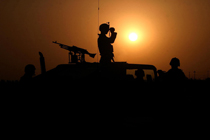
Frontline’s new documentary presents a timeline of the Iraq War punctuated by ill-prepared leadership, rushed military decision-making, and needless political snafus. That’s a now-familiar litany of disaster, but Endgame adds to the record with first-hand concessions from some of the retired Army generals who planned and executed the war. Their candid interviews—particularly one with retired Army General Jack Keane, the Army’s second in command during the 2003 invasion–drive the film and provide a new perspective on its military and political failings.
Endgame, which airs June 19 on PBS and will be posted afterward online, is the fifth in a series of Frontline segments on the Iraq War from producer Michael Kirk. It isn’t a pretty tale. There’s no light at the end of the tunnel here; no hope for a clean exit. Early in the film, New York Times reporter Michael Gordon identifies wishful thinking as the war’s fatal flaw: “From the day we got in, the plan was to get out at the earliest possible opportunity.” This half-hearted approach turned an initial victory into a vicious slog. “We never even considered an insurgency as a reasonable option,” Keane admits. “From the time we took the regime down, we never made a commitment to secure the population, and never had the resources to do it.”
Just trying to follow the war’s shifting cast of commanders and official strategies, not to mention its accumulation of missed opportunities, can be mind boggling. Endgame starts with the appointment of Ricardo Sanchez, the former tank division commander who was suddenly put in charge of the 2003 invasion. Washington Post reporter Thomas Ricks describes him the Army’s most “junior”—i.e., inexperienced—lieutenant general. In addition to being untested, Sanchez was never given a coherent strategy to execute.
Sanchez was replaced by General George Casey Jr., “a guy in charge of the biggest American war since Vietnam and nobody knows who he is,” as Times’ correspondent Dexter Filkins puts it. Casey consolidated American bases in Iraq in an effort to implement the “light footprint” strategy, a theory that our visibility should be minimized to discourage the Iraqis’ dependency on and dislike of U.S. forces. Meanwhile, the military’s missteps where exacerbated by political infighting back home. Secretary of State Condoleeza Rice undermined the light-footprint plan by pushing the “clear, hold and build” approach, in which American troops go door to door clearing insurgents from an area and then maintain an ongoing presence. Like many official decisions in Iraq, it’s another case of too little, too late.
The current troop surge is just the latest strategy to come out of this muddle. Reflecting on President Bush’s January announcement to send 20,000 additional troops to Iraq, Col. Thomas X. Hammes scoffs, “If you’re talking 20,000 or 30,000 troops over the next X number of months, that’s not a surge, it’s a dribble. You’re going to dribble more forces in and hope it has some impact.” The surge will be at full force by the Fourth of July, but its success won’t be officially determined until September.
So where does this leave us? “We’re nowhere near the endgame,” explains State Department counselor Phillip Zelikow toward the film’s end. “The only way we’re near the endgame is if we decide that Iraq’s no longer gonna be our problem and we’re just gonna get out.” Filkins takes a more philosophical approach, alluding to the arc of a Greek tragedy: “In this particular narrative, the hero has gathered himself and seen his errors and tried to get everything right. And maybe it’s too late.”
No matter what you think of the war, Endgame’s exploration of how we’re fighting it by the seat of our pants is deeply discouraging. How to end a game that never had a gameplan in the first place?













